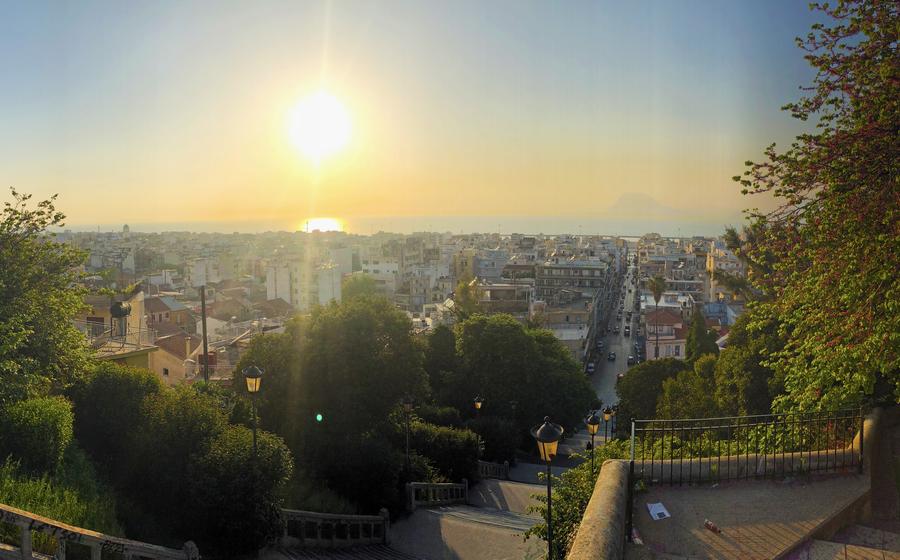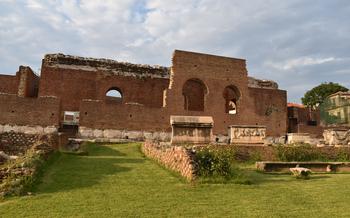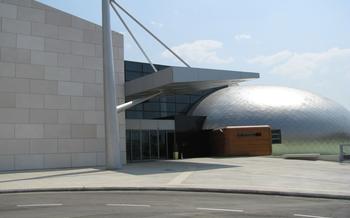
The Roman Bathhouse
- Historical Significance
- Location and Accessibility:
- Architectural Features
- Social and Cultural Importance
- Excavation and Restoration
- Current State and Accessibility
- Historical Context
- Interactive Displays and Exhibits
- Events and Activities
- The Roman Bathhouse in Literature and Art
- Tips for Visitors: Making the Most of Your Visit
- Photography and Videography
- Insider Tip:
Historical Significance
Embedded in the heart of Patras, the Roman Bathhouse stands as a testament to the grandeur and influence of the Roman Empire. Dating back to the 2nd century AD, this architectural marvel served as a public bathing facility, fulfilling not only a practical purpose but also playing a crucial role in the social and cultural life of the city.
Constructed with impressive engineering techniques and materials, the bathhouse showcases the Romans' mastery of architecture and design. Its well-preserved remains offer a glimpse into the intricate bathing rituals and customs that were an integral part of Roman culture.
Here, visitors are transported back in time, immersing themselves in the daily lives of the ancient Romans. They can envision the bustling atmosphere of the bathhouse, where people from all walks of life congregated to cleanse, relax, and socialize.
The Roman Bathhouse in Patras is a living testament to the enduring legacy of the Roman Empire. Its historical significance extends beyond its architectural splendor, embodying the cultural traditions and social interactions that shaped an era.
Location and Accessibility:
The Roman Bathhouse is conveniently located in the heart of Patras, a short walk from the Roman Odeon. Its central location makes it easily accessible on foot or by public transportation. Visitors can take advantage of the city's efficient bus network, with several bus lines stopping within walking distance of the site. For those arriving by car, there are several nearby parking options, including both on-street parking and public parking lots. Additionally, the Roman Bathhouse is situated near the Archaeological Museum of Patras, another significant attraction that offers a deeper dive into the city's rich history. To enhance your visit, consider following a map or using directions to navigate your way to this well-preserved archaeological gem.
Architectural Features
The Roman Bathhouse in Patras boasts an impressive domed structure that exemplifies its unique architectural style. This magnificent dome serves as a centerpiece, allowing natural light to flood the interior spaces and creating a sense of grandeur. The bathhouse is divided into three main sections: the frigidarium, tepidarium, and caldarium.
The frigidarium, or cold room, features a large pool filled with cool water. This room was used for the initial cleansing and cooling down after the bathing process. In contrast, the tepidarium, or warm room, contains a basin of warm water, providing a gradual transition between the frigidarium and the caldarium.
The caldarium, or hot room, is the heart of the bathhouse. It houses a large heated pool, where bathers could soak and relax in the soothing warmth. The intricate mosaic floors and wall paintings depicting Roman mythology add to the opulent ambiance of this space. The bathhouse's advanced heating system, utilizing hypocausts or underfloor heating, ensured a constant supply of hot water and regulated the temperature of the different rooms.
Social and Cultural Importance
The Roman Bathhouse in Patras served as a crucial social hub, facilitating interactions and fostering a sense of community among its patrons. Beyond its primary function as a bathing facility, the bathhouse played a significant role in the social and cultural life of the city. It provided a space for individuals to socialize, network, and engage in intellectual discussions. The baths became a meeting ground for philosophers, politicians, and scholars, who gathered to exchange ideas and debate current events. The atmosphere was conducive to lively conversations and the sharing of knowledge. Additionally, the bathhouse was used for religious rituals and festivals, further cementing its role as a central social and cultural institution in Roman Patras. The bathhouse's emphasis on hygiene and public health also contributed to its social importance, as it promoted a healthier and more vibrant community.
Excavation and Restoration
The discovery of the Roman Bathhouse in the 19th century during archaeological excavations marked a significant moment in uncovering the history of Patras. Extensive restoration efforts were undertaken to preserve this remarkable site and bring it back to life. The challenges faced in restoring the bathhouse to its former glory were immense, requiring meticulous attention to detail and adherence to historical accuracy. The restoration project involved careful cleaning, excavation, and reconstruction, ensuring the preservation of the site's original features. The successful restoration of the Roman Bathhouse stands as a testament to the dedication and expertise of the archaeologists and conservators involved, preserving this valuable piece of cultural heritage for future generations to appreciate and enjoy.
Current State and Accessibility
The Roman Bathhouse stands today as a remarkably well-preserved archaeological site, a testament to the enduring legacy of Roman engineering and architecture. Visitors can freely explore the ruins, immersing themselves in the ancient world. Guided tours led by knowledgeable experts offer an immersive experience, providing insights into the history, architecture, and daily life of the Roman Bathhouse. These tours bring the site to life, allowing visitors to imagine the bustling activity and social interactions that once filled these spaces. The Roman Bathhouse is a site of great cultural significance, and its preservation and protection are of paramount importance. Visitors are encouraged to respect and care for this invaluable piece of history, ensuring its preservation for generations to come. Opening hours, admission fees, and contact details can be found on the official website of the Roman Bathhouse, making it easy for visitors to plan their visit and fully experience this captivating historical landmark.
Historical Context
The Roman Bathhouse in Patras cannot be understood without considering the broader context of Roman Patras. This vibrant city was a significant port and commercial hub within the Roman Empire, serving as a gateway to the Peloponnese and beyond. The construction of the bathhouse reflects Patras's status as a thriving metropolis, where Roman culture deeply influenced urban development and daily life.
During the Roman period, Patras underwent significant growth and prosperity. The city's strategic location on the Gulf of Patras and its proximity to major trade routes contributed to its economic success. Patras became a bustling center for maritime trade, with goods flowing in and out of the city's harbor. The city's wealth and prominence attracted Roman settlers, merchants, and officials, who brought with them Roman customs and traditions.
The influence of Roman culture on Patras is evident in various aspects of the city's urban landscape, architecture, and public infrastructure. The construction of the Roman Bathhouse stands as a testament to the Romanization of Patras. This impressive structure not only served as a place for bathing and relaxation but also symbolized the adoption of Roman bathing customs and the integration of Patras into the broader Roman world.
Interactive Displays and Exhibits
To enhance the visitor experience, the Roman Bathhouse features a range of interactive displays and exhibits that bring its history, architecture, and daily life to life. These displays employ multimedia presentations, touchscreens, and virtual reality to engage visitors and provide deeper insights into the ancient world. Visitors can explore interactive maps, view 3D reconstructions of the bathhouse, and immerse themselves in virtual reality experiences that simulate the bathing rituals of the Romans. These interactive elements not only entertain but also educate, helping visitors gain a deeper understanding of the Roman culture and way of life.
Events and Activities
The Roman Bathhouse is not just a static historical site; it also serves as a vibrant venue for various events and activities throughout the year. Visitors can immerse themselves in the site's rich history and culture through a range of engaging programs.
One of the highlights is the historical reenactments that bring the past to life. Actors dressed in authentic Roman attire recreate scenes from daily life in the bathhouse, allowing visitors to experience the rituals and customs of the ancient Romans firsthand. These reenactments offer a unique and interactive way to learn about the site's history.
For those interested in delving deeper into the history and architecture of the bathhouse, guided tours and educational programs are available. Expert guides provide insights into the construction techniques, bathing customs, and social significance of the site, making the visit more informative and enriching.
Additionally, the Roman Bathhouse serves as a platform for cultural exhibitions, concerts, and performances. These events showcase the diverse talents of local artists and performers, creating a vibrant atmosphere that blends history with contemporary creativity. Visitors can enjoy live music, theatrical performances, art installations, and more, all while exploring the ancient ruins.
These events and activities not only enhance the visitor experience but also contribute to the preservation and promotion of the Roman Bathhouse as a cultural heritage site. They provide a platform for the local community to engage with their history and celebrate their cultural identity.
The Roman Bathhouse in Literature and Art
The Roman Bathhouse in Patras has captured the imagination of writers, artists, and filmmakers throughout history. Its unique architectural features and historical significance have served as inspiration for numerous works of literature, art, and popular culture.
In literature, the Roman Bathhouse has been featured in several novels and short stories. One notable example is "The Roman Bath" by Victoria Hislop, which tells the story of a young English girl who travels to Patras to uncover the secrets of her family's past. The novel vividly describes the bathhouse and its role in the lives of the city's inhabitants.
In art, the Roman Bathhouse has been depicted in paintings, drawings, and sculptures by both local and international artists. One famous painting is "The Roman Baths, Patras" by the Greek artist Yannis Tsarouchis, which captures the beauty and tranquility of the site.
The bathhouse has also appeared in several films and documentaries. One notable example is the 2005 documentary "The Roman Baths of Patras," which provides a comprehensive overview of the site's history, architecture, and cultural significance.
These artistic representations of the Roman Bathhouse not only showcase its historical and architectural importance but also contribute to its cultural significance. They allow visitors to experience the site through the eyes of artists and writers, gaining a deeper appreciation for its beauty and history.
Tips for Visitors: Making the Most of Your Visit
To ensure a memorable and enjoyable experience at the Roman Bathhouse, here are some practical tips for visitors:
-
Timing is Everything: Plan your visit during the early morning or late afternoon to avoid the midday crowds and heat. This will allow you to explore the site at a more leisurely pace and capture stunning photos without distractions.
-
Dress for Comfort: Wear comfortable clothing and sturdy, non-slip footwear suitable for walking on uneven surfaces. The bathhouse's ancient stone floors can be slippery, so proper footwear is essential for safety.
-
Facilities and Amenities: Restrooms are available on-site for visitor convenience. However, there are no cafes or gift shops within the bathhouse itself. Consider bringing water and any necessary snacks with you, as there are limited options for refreshments in the immediate vicinity.
-
Guided Tours: Take advantage of guided tours offered by local experts to gain deeper insights into the history, architecture, and significance of the Roman Bathhouse. These tours provide a wealth of information and allow you to ask questions and engage with knowledgeable guides.
-
Photography and Videography: The Roman Bathhouse offers ample opportunities for photography and videography. Capture the impressive architectural details, intricate mosaics, and the overall ambiance of the site. Remember to follow any guidelines or restrictions regarding photography and videography on the premises.
Photography and Videography
The Roman Bathhouse presents ample opportunities for photography and videography enthusiasts to capture the site's architectural grandeur and historical significance. With its well-preserved structures, intricate mosaics, and atmospheric ambiance, the bathhouse offers a visually captivating subject for photographers and videographers alike.
To capture the best shots, consider arriving early in the morning or late in the afternoon when the light is softer and more flattering. Experiment with different angles to showcase the bathhouse's impressive domed structure, intricate columns, and mosaic floors. Don't forget to capture details like the carvings on the walls and the remnants of the heating system.
Please be mindful of any restrictions or guidelines regarding photography and videography on the site. Using a tripod may be prohibited in certain areas, so be prepared to shoot handheld or use a monopod if necessary.
For aspiring videographers, the Roman Bathhouse offers a chance to create immersive and educational videos. Consider incorporating drone footage to provide a bird's-eye view of the site and its surroundings. Interviews with historians or archaeologists can add depth and context to your videos, helping viewers understand the significance of this ancient landmark.
Whether you're a professional photographer or simply a passionate traveler with a camera, the Roman Bathhouse is a treasure trove of visual wonders waiting to be captured and shared with the world.
Insider Tip:
To enhance your visit to the Roman Bathhouse, I highly recommend exploring the nearby culinary delights of Patras. Just a short walk from the site, you'll find a charming taverna called "To Patriko Mas." This family-run establishment serves authentic Greek cuisine prepared with fresh, local ingredients. Indulge in traditional dishes such as moussaka, pastitsio, and succulent grilled meats. Pair your meal with a glass of local wine or ouzo, and immerse yourself in the warm and welcoming atmosphere.
After your delicious meal, take a leisurely stroll along the picturesque promenade of Patras. Admire the stunning views of the Gulf of Patras and the distant mountains. You may even spot the historic Rio-Antirio Bridge, an architectural marvel that connects the Peloponnese to mainland Greece.
For an unforgettable experience, book a guided tour of the Roman Bathhouse. Knowledgeable local guides will provide fascinating insights into the history, architecture, and cultural significance of this ancient site. Their passion and expertise will bring the past to life, allowing you to fully appreciate the grandeur of the Roman Bathhouse.
Finally, don't miss the opportunity to explore other historical and cultural gems in Patras. Visit the Archaeological Museum of Patras to delve deeper into the region's rich past. Admire the impressive collection of artifacts, including pottery, sculptures, and jewelry that tell the story of Patras from prehistoric times to the Roman era.
With its captivating history, stunning architecture, and delicious cuisine, Patras is a city that will enchant and inspire you. Embark on a journey through time as you explore the Roman Bathhouse and uncover the secrets of this ancient city.









